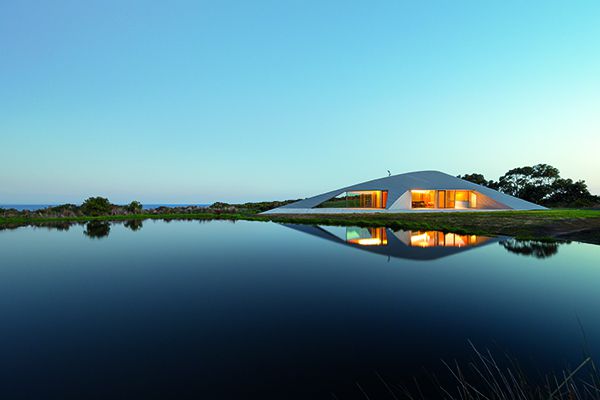If the natural elements of rain, sun, and wind could generate architecture what would it look like?

May 25th, 2016
James Stockwell’s brief for this rural home on Victoria’s south east coast was to develop an environmentally sustainable home, which would provide a panoramic view of, as well as shelter from, the coastline in all directions. The vision for The Croft House was for an unobtrusive structure, which was harmonious with nature, organic, unembellished, and timeless in its design.
Completed in 2013, the home has been named a finalist for commercial and residential architecture in this year’s Good Design Awards.
To begin the project, Stockwell investigated both the geology and climate of the site. “My brother is a geologist and he and I begin by looking at the geology of a project and determine the changing shape of the landscape in geological time,” he says.
The concept of Biophilia, and the idea that there is an instinctive bond between human beings and other living systems, also informed Rockwell’s ultimate, environmentally centred design. “Each natural system – wind, sun, rain – is considered to develop a design that is less protection from the elements and more engagement with the elements.”
“We inherently desire closeness to the natural world, so the roles of architecture to protect us from it, as well as enable us to embrace it seem to be opposed. The optical illusion of a shield like exterior in this case is contrasted by an expansive interior and tapered walls permit peripheral vision to extend the view lines outward.”
“Engineer Professor Max Irvine alerted us to the sine curve, the harmonic curve of sound and ocean waves,” Stockwell continues. “The house is formed within three sine curves shaped to serve the domestic functions. The curved shell form is ‘alive’ and carries the eye to the undulating lines in the landscape beyond.”
Beach sand from the coast was used to form compressed sand internal walls for thermal mass so no extra heating is required in winter. Running costs are also minimized by double-glazing and a passive solar design. The house provides high fire protection.
The entire structure is finished in local timber – Victorian ash, and bluestone in wet areas. Externally, the outer walls are clad in zinc. “Zinc is a noble metal like copper so will last hundreds of years. It suited the shale geology muted tones and could be rolled into corrugated sheets to suit the farming vernacular.”
Photography credit: Exterior – James Archibald, Interior – John Gollings.
James Stockwell Architect
stockwelldesign.com.au
A searchable and comprehensive guide for specifying leading products and their suppliers
Keep up to date with the latest and greatest from our industry BFF's!

In this candid interview, the culinary mastermind behind Singapore’s Nouri and Appetite talks about food as an act of human connection that transcends borders and accolades, the crucial role of technology in preserving its unifying power, and finding a kindred spirit in Gaggenau’s reverence for tradition and relentless pursuit of innovation.

Elevate any space with statement lighting to illuminate and inspire.
The internet never sleeps! Here's the stuff you might have missed

This upcoming panel, Sustainability in Transport Design & Assessing Environmental Impact, will explore the sustainability initiatives at the heart of transport design.

Attendees of the Sustainability Summit will have an extraordinary chance to win a luxurious adult-only retreat to one of South Australia’s finest destinations

Fresh from Singapore, the first round of winners from day one of the World Architecture Festival have been announced.

Italian furniture brand Pedrali is known for leading the way when it comes to the workplace. We speak with Busetti Garuti Redaelli design studio about the evolution of the Buddy collection – a solution for hybrid spaces that can support all sorts of working styles.